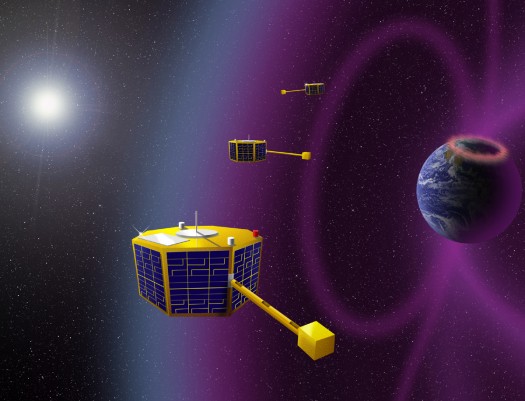Space Buoys
July 2008By Dr. Tony Phillips
Dr. Tony Phillips;Oh, there’s just one problem: You’ve got to do this work using no more than one ocean buoy.
“That would be impossible,” says Dr. Guan Le of the Goddard Space Flight Center. “The Pacific’s too big to understand by studying just one location.”
Yet, for Le and her space scientist colleagues, this was exactly what they have been expected to accomplish in their own studies of Earth’s magnetosphere. The magnetosphere is an “ocean” of magnetism and plasma surrounding our planet. Its shores are defined by the outer bounds of Earth’s magnetic field and it contains a bewildering mix of matter-energy waves, electrical currents and plasma oscillations spread across a volume billions of times greater than the Pacific Ocean itself.
“For many years we’ve struggled to understand the magnetosphere using mostly single spacecraft,” says Le. “To really make progress, we need many spacecraft spread through the magnetosphere, working together to understand the whole.”
Enter Space Technology 5.
In March 2006 NASA launched a trio of experimental satellites to see what three “buoys” could accomplish. Because they weighed only 55 lbs. apiece and measured not much larger than a birthday cake, the three ST5 “microsatellites” fit onboard a single Pegasus rocket. Above Earth’s atmosphere, the three were flung like Frisbees from the rocket’s body into the magnetosphere by a revolutionary micro-satellite launcher.
Space Technology 5 is a mission of NASA’s New Millennium Program, which tests innovative technologies for use on future space missions. The 90-day flight of ST5 validated several devices crucial to space buoys: miniature magnetometers, high-efficiency solar arrays, and some strange-looking but effective micro-antennas designed from principles of Darwinian evolution. Also, ST5 showed that three satellites could maneuver together as a “constellation,” spreading out to measure complex fields and currents.
“ST5 was able to measure the motion and thickness of current sheets in the magnetosphere,” says Le, the mission’s project scientist at Goddard. “This could not have been done with a single spacecraft, no matter how capable.”
The ST5 mission is finished but the technology it tested will key future studies of the magnetosphere. Thanks to ST5, hopes Le, lonely buoys will soon be a thing of the past.
Learn more about ST5’s miniaturized technologies at nmp.nasa.gov/st5. Kids (and grownups) can get a better understanding of the artificial evolutionary process used to design ST5’s antennas at spaceplace.nasa.gov/en/kids/st5/emoticon.

The Space Technology 5 micro-satellites proved the feasibility of using a constellation of small spacecraft
with miniature magnetometers to study Earth’s magnetosphere.
This article was provided by the Jet Propulsion
Laboratory, California Institute of Technology,
under a contract with the National Aeronautics
and Space Administration.



